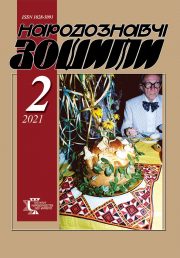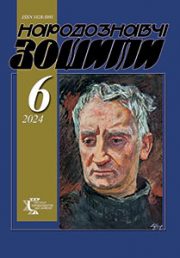The Ethnology Notebooks, 2018, № 5 (143), 1168—1175
UDK 7.071.1:7.021.7(477.85/.87)
DOI https://doi.org/10.15407/nz2018.05.1168
Received 15.07.2018
WOODCARVING AND METALWORKING IN HUTSULSHCHYNA IN THE FIRST HALF OF THE NINETEENTH CENTURY
ORCID ID: https://orcid.org/0000-0001-7130-2338
Jusypchuk Jurii, Candidate of Sciences in Art Studies,
Associate Professor, Educational-scientific Institute
of arts department of methodology of teaching graphic,
decoratively-applied art and design
str. Hrushevskyi 33/6, Ivano-Frankivsk, Ukraine
Contacts: tel. 0679875624; e-mail: yusupchuk@meta.ua
Abstrakt. The article analyzes modern traditions in the culture of carving and metalworking in the Hutsulshchyna. The historical and sociocultural backgrounds of their formation are indicated. The typology of works of this art in the first half of the nineteenth century is clarified.
Keywords: Hutsuls` art, metalworking, woodcarving, typology of works of Hutsuls` metalworking art.
REFERENCES
Bonkovska, S.M. (1997). Do genezisu gutsulskih nagrudnyh hrestiv. Ukraynska hrestologiya. Spetsialnyi vypusk Narodoznavchyh zoshytiv Institutu narodoznavstva NAN Ukrainy, 31—36 [in Ukrainian].
Budzan, A.F. (1960). Rizba po derevu v zahidnyh oblastyah Ukrainy. Kyiv [in Ukrainian].
Valko, O. (1997). Gutsulskyi midnyi hrestyk XVII ст. Ukraynska hrestologiya, 41—44 [in Ukrainian].
Gesse, G. (1983). Gra v biser. Kyiv [in Ukrainian].
Zholhovskiy, P. (1962). Hudozhnyi metal. In Ukraynske narodne mystetstvo. Rizblennya ta hudozhnyi metal: Albom (p, 113). Kyiv [in Ukrainian].
Zholhovskiy, P. (1972). Hudozhnyi metal: Istorichnyi narys. Kyiv: Mystetstvo [in Ukrainian].
Mozdyr, М.І. (1987). Rizbjarstwo. In Gutsulshchyna: Istoriko-etnografichne doslidzhennya (pp. 388—405). Kyiv [in Ukrainian].
Okunevskyi, Т. (1879). Nashe rizbyarstvo. Gospodar i promyshlennik, 3, 43—45. Stanislavov [in Ukrainian].
Savchuk, G. (1987). Gutsulski zhinochi prykrasy. NTE, 5, 50.
Slovo. 1875,19, 4 [in Ukrainian].
Stankevich, М. (1994). Dо typologii Hresta. Rodovid, 8, 62 [in Ukrainian].
Stankevich, М.E., Antonovich, E., & Zaharchuk-Chugay, R. (1992). Mystetztvoznavchi aspecty teorii traditzii. In Decoratyvno-prykladne mystetztvo: posibnyk. Lviv [in Ukrainian].
Stankevich, М.E. (1996). Ridkisni rizbleni ikony-hresty XVII — poch. ХІХ st. Ukrainska narodna tvorchist u ponnyatyah mizhnarodnoi terminologii: Kollectyvne doslidzhennya za materialamy Drugyh Goncharivskyh chitan. Kyiv, 104—109 [in Ukrainian].
Stankevich, М. (1997). Struktura hudozhnyogo teksty hrysta. Ukrainska Hrestologiya, 14 [in Ukrainian].
Stankevich, М.E. (2002). Ukrainske художнє дерево XVI—ХХ ст. Львів [in Ukrainian].
Stankevich, М.E. , Antonovich E., & Zaharchuk-Chugay, R. (1992). Chudoznij metal. In Decoratyvno-prykladne mystetztvo: posibnyk. Lviv [in Ukrainian].
Suha, L. (1955). Hudozhni metalevi vyroby ukraintsiv Shidnyh Karpat drugoi polovyny ХІХ—ХХ st. Kyiv [in Ukrainian].
Shuhevych, V. (1997). Gutsulshchyna: Repting. vyd. 1899 р. Verhovyna [in Ukrainian].
Hacquet, B. (1798). Neueste Physikalisch-politische Reisen (Vol. 3). Nurnberg
Karpińska, I. (1936). Huculszcyzna. Spółnota pracy: Przemysł i sztuka ludowa, 24, 32—33 [in Polish].






